
Question Number 202500 by Calculusboy last updated on 28/Dec/23

Answered by Frix last updated on 28/Dec/23

$$\mathrm{Obviously}\:{x}=\mathrm{1} \\ $$$$\sqrt[{\mathrm{2015}}]{\mathrm{1}+\mathrm{3}−\mathrm{3}}+\sqrt[{\mathrm{2015}}]{−\mathrm{1}−\mathrm{3}+\mathrm{5}}=\mathrm{1}+\mathrm{1}=\mathrm{2} \\ $$
Answered by Rasheed.Sindhi last updated on 28/Dec/23
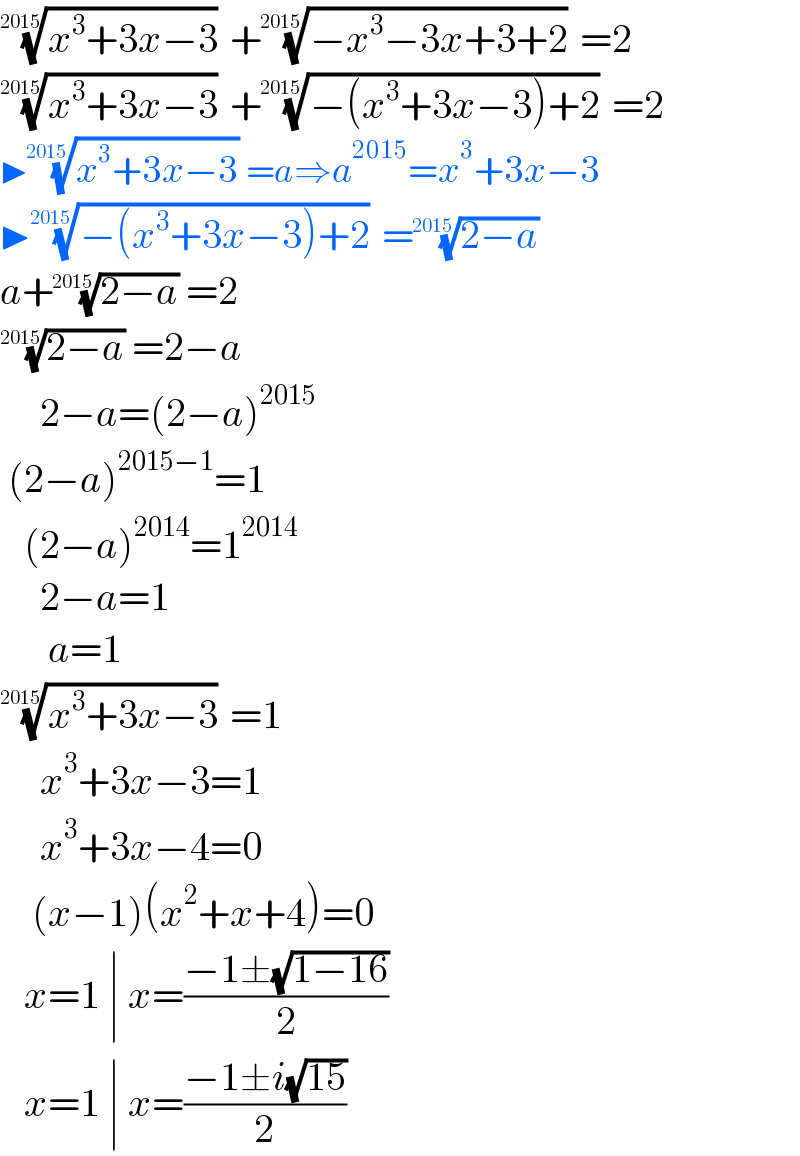
$$\sqrt[{\mathrm{2015}}]{{x}^{\mathrm{3}} +\mathrm{3}{x}−\mathrm{3}}\:+\sqrt[{\mathrm{2015}}]{−{x}^{\mathrm{3}} −\mathrm{3}{x}+\mathrm{3}+\mathrm{2}}\:=\mathrm{2} \\ $$$$\sqrt[{\mathrm{2015}}]{{x}^{\mathrm{3}} +\mathrm{3}{x}−\mathrm{3}}\:+\sqrt[{\mathrm{2015}}]{−\left({x}^{\mathrm{3}} +\mathrm{3}{x}−\mathrm{3}\right)+\mathrm{2}}\:=\mathrm{2} \\ $$$$\blacktriangleright\sqrt[{\mathrm{2015}}]{{x}^{\mathrm{3}} +\mathrm{3}{x}−\mathrm{3}}\:={a}\Rightarrow{a}^{\mathrm{2015}} ={x}^{\mathrm{3}} +\mathrm{3}{x}−\mathrm{3} \\ $$$$\blacktriangleright\sqrt[{\mathrm{2015}}]{−\left({x}^{\mathrm{3}} +\mathrm{3}{x}−\mathrm{3}\right)+\mathrm{2}}\:=\sqrt[{\mathrm{2015}}]{\mathrm{2}−{a}}\: \\ $$$${a}+\sqrt[{\mathrm{2015}}]{\mathrm{2}−{a}}\:=\mathrm{2} \\ $$$$\sqrt[{\mathrm{2015}}]{\mathrm{2}−{a}}\:=\mathrm{2}−{a} \\ $$$$\:\:\:\:\:\mathrm{2}−{a}=\left(\mathrm{2}−{a}\right)^{\mathrm{2015}} \\ $$$$\:\left(\mathrm{2}−{a}\right)^{\mathrm{2015}−\mathrm{1}} =\mathrm{1} \\ $$$$\:\:\:\left(\mathrm{2}−{a}\right)^{\mathrm{2014}} =\mathrm{1}^{\mathrm{2014}} \\ $$$$\:\:\:\:\:\mathrm{2}−{a}=\mathrm{1} \\ $$$$\:\:\:\:\:\:{a}=\mathrm{1} \\ $$$$\sqrt[{\mathrm{2015}}]{{x}^{\mathrm{3}} +\mathrm{3}{x}−\mathrm{3}}\:=\mathrm{1} \\ $$$$\:\:\:\:\:{x}^{\mathrm{3}} +\mathrm{3}{x}−\mathrm{3}=\mathrm{1} \\ $$$$\:\:\:\:\:{x}^{\mathrm{3}} +\mathrm{3}{x}−\mathrm{4}=\mathrm{0} \\ $$$$\:\:\:\:\left({x}−\mathrm{1}\right)\left({x}^{\mathrm{2}} +{x}+\mathrm{4}\right)=\mathrm{0} \\ $$$$\:\:\:{x}=\mathrm{1}\:\mid\:{x}=\frac{−\mathrm{1}\pm\sqrt{\mathrm{1}−\mathrm{16}}}{\mathrm{2}} \\ $$$$\:\:\:{x}=\mathrm{1}\:\mid\:{x}=\frac{−\mathrm{1}\pm{i}\sqrt{\mathrm{15}}}{\mathrm{2}} \\ $$
Commented by Rasheed.Sindhi last updated on 28/Dec/23

$${Erraneous}\:{answer}! \\ $$
Commented by Frix last updated on 28/Dec/23
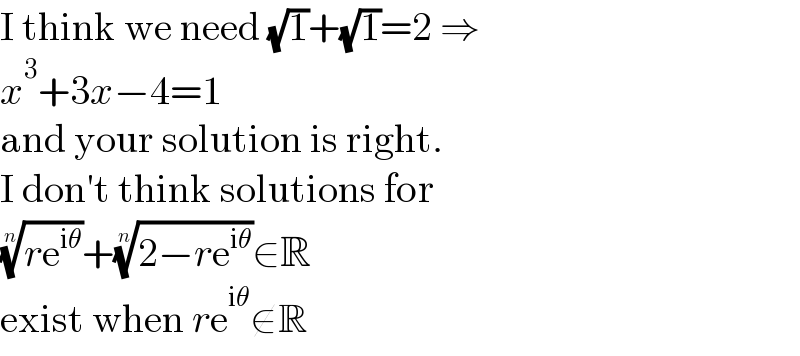
$$\mathrm{I}\:\mathrm{think}\:\mathrm{we}\:\mathrm{need}\:\sqrt{\mathrm{1}}+\sqrt{\mathrm{1}}=\mathrm{2}\:\Rightarrow \\ $$$${x}^{\mathrm{3}} +\mathrm{3}{x}−\mathrm{4}=\mathrm{1} \\ $$$$\mathrm{and}\:\mathrm{your}\:\mathrm{solution}\:\mathrm{is}\:\mathrm{right}. \\ $$$$\mathrm{I}\:\mathrm{don}'\mathrm{t}\:\mathrm{think}\:\mathrm{solutions}\:\mathrm{for} \\ $$$$\sqrt[{{n}}]{{r}\mathrm{e}^{\mathrm{i}\theta} }+\sqrt[{{n}}]{\mathrm{2}−{r}\mathrm{e}^{\mathrm{i}\theta} }\in\mathbb{R} \\ $$$$\mathrm{exist}\:\mathrm{when}\:{r}\mathrm{e}^{\mathrm{i}\theta} \notin\mathbb{R} \\ $$
Commented by esmaeil last updated on 28/Dec/23

$${if}\left(\sqrt[{\mathrm{2015}}]{{x}^{\mathrm{3}} +\mathrm{3}{x}−\mathrm{3}}={a}\right)\rightarrow \\ $$$$\sqrt[{\mathrm{2015}}]{\mathrm{2}−\left({x}^{\mathrm{3}} +\mathrm{3}{x}−\mathrm{3}\right)}=\sqrt[{\mathrm{2015}}]{\mathrm{2}−{a}^{\mathrm{2015}} } \\ $$$$\neq\sqrt[{\mathrm{2015}}]{\mathrm{2}−{a}} \\ $$
Commented by Frix last updated on 28/Dec/23

$$\mathrm{But}\:\mathrm{if}\:{x}^{\mathrm{3}} +\mathrm{3}{x}−\mathrm{3}={a}\:\Rightarrow\:\sqrt[{\mathrm{2015}}]{{a}}+\sqrt[{\mathrm{2015}}]{\mathrm{2}−{a}} \\ $$
Commented by esmaeil last updated on 28/Dec/23

$${yes} \\ $$$${but}\:{it}\:{dosn}'{t}\:{help}\:\:{us}\:{to}\:{solve}\:{that}. \\ $$
Commented by Frix last updated on 28/Dec/23

$$\mathrm{It}\:\mathrm{helps}\:\mathrm{to}\:\mathrm{see}\:\mathrm{there}'\mathrm{s}\:\mathrm{no}\:\mathrm{other}\:\mathrm{solutions} \\ $$$$\mathrm{besides}\:{a}=\mathrm{1}. \\ $$
Commented by Calculusboy last updated on 28/Dec/23

$$\boldsymbol{{thanks}}\:\boldsymbol{{sir}} \\ $$
Commented by Rasheed.Sindhi last updated on 29/Dec/23

$$\mathbb{T}\boldsymbol{\mathrm{hanks}}\:\boldsymbol{\mathrm{sir}}\:\mathrm{for}\:\boldsymbol{\mathrm{guidance}}! \\ $$
Answered by Rasheed.Sindhi last updated on 28/Dec/23
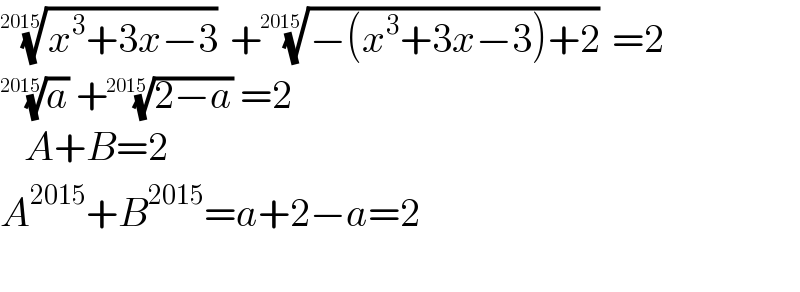
$$\sqrt[{\mathrm{2015}}]{{x}^{\mathrm{3}} +\mathrm{3}{x}−\mathrm{3}}\:+\sqrt[{\mathrm{2015}}]{−\left({x}^{\mathrm{3}} +\mathrm{3}{x}−\mathrm{3}\right)+\mathrm{2}}\:=\mathrm{2} \\ $$$$\sqrt[{\mathrm{2015}}]{{a}}\:+\sqrt[{\mathrm{2015}}]{\mathrm{2}−{a}}\:=\mathrm{2} \\ $$$$\:\:\:{A}+{B}=\mathrm{2} \\ $$$${A}^{\mathrm{2015}} +{B}^{\mathrm{2015}} ={a}+\mathrm{2}−{a}=\mathrm{2} \\ $$$$ \\ $$
Answered by Rasheed.Sindhi last updated on 29/Dec/23
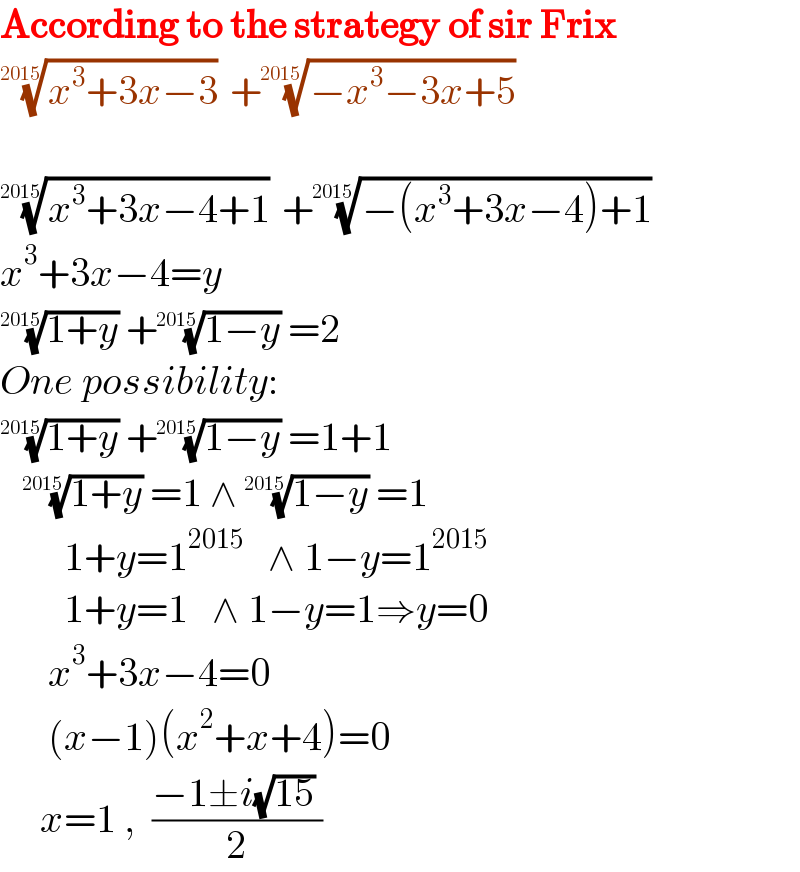
$$\boldsymbol{\mathrm{According}}\:\boldsymbol{\mathrm{to}}\:\boldsymbol{\mathrm{the}}\:\boldsymbol{\mathrm{strategy}}\:\boldsymbol{\mathrm{of}}\:\boldsymbol{\mathrm{sir}}\:\boldsymbol{\mathrm{Frix}} \\ $$$$\sqrt[{\mathrm{2015}}]{{x}^{\mathrm{3}} +\mathrm{3}{x}−\mathrm{3}}\:+\sqrt[{\mathrm{2015}}]{−{x}^{\mathrm{3}} −\mathrm{3}{x}+\mathrm{5}} \\ $$$$\: \\ $$$$\sqrt[{\mathrm{2015}}]{{x}^{\mathrm{3}} +\mathrm{3}{x}−\mathrm{4}+\mathrm{1}}\:+\sqrt[{\mathrm{2015}}]{−\left({x}^{\mathrm{3}} +\mathrm{3}{x}−\mathrm{4}\right)+\mathrm{1}} \\ $$$${x}^{\mathrm{3}} +\mathrm{3}{x}−\mathrm{4}={y} \\ $$$$\sqrt[{\mathrm{2015}}]{\mathrm{1}+{y}}\:+\sqrt[{\mathrm{2015}}]{\mathrm{1}−{y}}\:=\mathrm{2} \\ $$$${One}\:{possibility}: \\ $$$$\sqrt[{\mathrm{2015}}]{\mathrm{1}+{y}}\:+\sqrt[{\mathrm{2015}}]{\mathrm{1}−{y}}\:=\mathrm{1}+\mathrm{1} \\ $$$$\:\:\:\sqrt[{\mathrm{2015}}]{\mathrm{1}+{y}}\:=\mathrm{1}\:\wedge\:\sqrt[{\mathrm{2015}}]{\mathrm{1}−{y}}\:=\mathrm{1} \\ $$$$\:\:\:\:\:\:\:\:\mathrm{1}+{y}=\mathrm{1}^{\mathrm{2015}} \:\:\:\wedge\:\mathrm{1}−{y}=\mathrm{1}^{\mathrm{2015}} \\ $$$$\:\:\:\:\:\:\:\:\mathrm{1}+{y}=\mathrm{1}\:\:\:\wedge\:\mathrm{1}−{y}=\mathrm{1}\Rightarrow{y}=\mathrm{0} \\ $$$$\:\:\:\:\:\:{x}^{\mathrm{3}} +\mathrm{3}{x}−\mathrm{4}=\mathrm{0} \\ $$$$\:\:\:\:\:\:\left({x}−\mathrm{1}\right)\left({x}^{\mathrm{2}} +{x}+\mathrm{4}\right)=\mathrm{0} \\ $$$$\:\:\:\:\:{x}=\mathrm{1}\:,\:\:\frac{−\mathrm{1}\pm{i}\sqrt{\mathrm{15}}\:}{\mathrm{2}} \\ $$
Commented by mr W last updated on 29/Dec/23
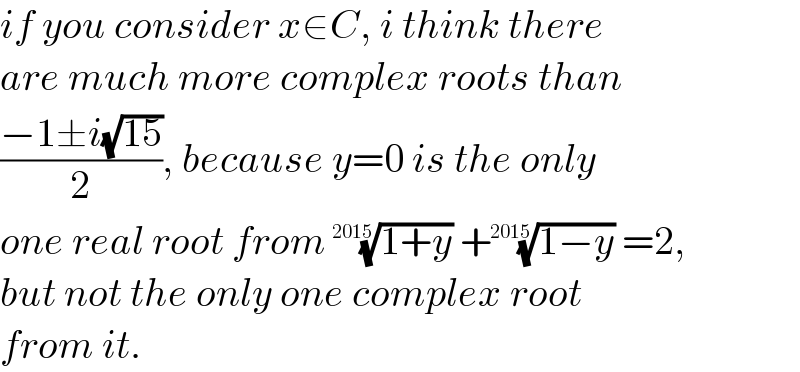
$${if}\:{you}\:{consider}\:{x}\in{C},\:{i}\:{think}\:{there}\: \\ $$$${are}\:{much}\:{more}\:{complex}\:{roots}\:{than} \\ $$$$\frac{−\mathrm{1}\pm{i}\sqrt{\mathrm{15}}}{\mathrm{2}},\:{because}\:{y}=\mathrm{0}\:{is}\:{the}\:{only}\: \\ $$$${one}\:{real}\:{root}\:{from}\:\sqrt[{\mathrm{2015}}]{\mathrm{1}+{y}}\:+\sqrt[{\mathrm{2015}}]{\mathrm{1}−{y}}\:=\mathrm{2}, \\ $$$${but}\:{not}\:{the}\:{only}\:{one}\:{complex}\:{root}\: \\ $$$${from}\:{it}. \\ $$
Commented by Frix last updated on 29/Dec/23

$$\mathrm{I}\:\mathrm{don}'\mathrm{t}\:\mathrm{think}\:\sqrt[{{n}}]{\mathrm{1}+{y}}+\sqrt[{{n}}]{\mathrm{1}−{y}}=\mathrm{2}\:\mathrm{has}\:\mathrm{complex} \\ $$$$\mathrm{roots}. \\ $$
